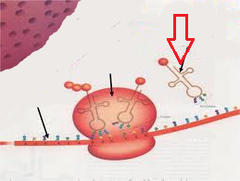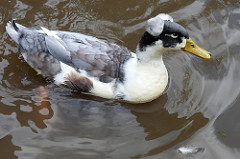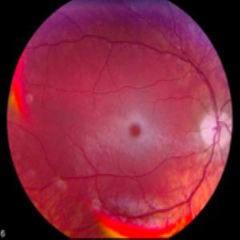Anatomy and Physiology – Cell Biology – Flashcards
Unlock all answers in this set
Unlock answersquestion
Replication

answer
The process by which DNA makes a copy of itself, occurs in nucleus 1) Helicase unwinds DNA strand and unzips it down the middle 2) DNA polymerase reads the unwound strands and lays down corresponding nitrogenous bases 3) Helicase zips strands back up and winds them into helix 4) Results in 2 identical DNA strands, half new, half old
question
Cell Division
answer
The process by which a cell divides into two new daughter cells. Each daughter cell must be provided with a complete copy of the parental cell DNA
question
Template Strand

answer
The DNA strand that provides the template for ordering the sequence of nucleotides in an RNA transcript.
question
Complimentary Strand
answer
The DNA strand that is created by RNA transcript.
question
Transcription

answer
(DNA-->mRNA) Process whereby the DNA sequence in a gene is copied into mRNA, occurs inside nucleus 1) Helicase unwinds and unzips new DNA strand 2) RNA Polymerase copies the DNA template into mRNA, replacing thymine with URACIL 3) mRNA leaves nucleus headed for a ribosome
question
Translation
answer
(mRNA-->proteins) Process in which genetic information coded in mRNA codons direct the FORMATION OF SPECIFIC PROTEINS at a ribosome in the cytoplasm, occurs in cytoplasm 1) rRNA in the ribosome reads message from mRNA 2) tRNA brings amino acids that match mRNA codons 3) A chain of amino acid begins to form 4) The completed chain forms a protein
question
mRNA
answer
messenger RNA; type of RNA that carries instructions from DNA in the nucleus to the ribosome in the cytoplasm
question
tRNA

answer
transfer RNA; type of RNA that carries amino acids to the ribosome -each tRNA is specific to an amino acid (20+)
question
rRNA
answer
A globular RNA that is combined with special protein that makes up a ribosome -transcribed from DNA in nucleolus
question
Codon
answer
A specific sequence of THREE adjacent bases on a strand of DNA or RNA -each codon provides genetic code information for ONE particular amino acid
question
Gene

answer
A specific piece of DNA (series of codons) that codes for a specific protein which has a functional role in our life.
question
RNA Polymerase

answer
An enzyme that links together the growing chain of RNA nucleotides during transcription, using a DNA strand as a template.
question
Promoter
answer
A specific nucleotide sequence in DNA that binds RNA polymerase and indicates where to start transcribing RNA.
question
Stop Codon
answer
The codon that ends all RNA translation (UAG, UAA, or UGA)
question
Anticodon
answer
A sequence of three bases of a tRNA molecule that hydrogen bonds with the complementary three-nucleotide codon of an mRNA molecule during translation
question
Mutation

answer
Any event that changes genetic structure of DNA/RNA
question
Point Mutation

answer
mutation that affects a single nucleotide, usually by substituting one nucleotide for another
question
Polysome
answer
A group of ribosomes moving along the same mRNA as they simultaneously translate it.
question
Tay-Sachs Disease

answer
An inherited disease in which a DEFICIENTCY OF LYSOSOMES where glycolipid accumulation in brain neurons causes mental retardation, blindness and eventual death
question
Free Ribosomes

answer
Ribosomes suspended in cytoplasm which will function in cytoplasm and not organelles (ex: enzymes)
question
Lysosomes

answer
A membrane bound sack containing digestive enzymes that can break down macromolecules such as proteins, nucleic acids, and polysaccharides
question
Rough Endoplasmic Reticulum
answer
System of internal membranes within the cytoplasm. Membranes are rough due to the presence of ribosomes. Functions in ASSEMBLY and TRANSPORT of PROTEINS to the golgi apparatus
question
Secretion
answer
The process in which a functionally specialized substance is released from a gland or cell by EXOCYTOSIS
question
Mitochondria
answer
An organelle found in large numbers in most cells, in which the biochemical processes of respiration and energy production occur.
question
Peroxisomes
answer
Abundant in the liver and kidney where they neutralize free radicals and detoxify alcohol and other drugs. Also break down fatty acids which mitochondria uses for energy.
question
Cytoskeleton
answer
A network of fibers that holds the cell together, helps the cell to keep its shape, and aids in movement
question
Microfilaments

answer
-ACTIN Filaments (made of actin) -Long, thin fibers -Function in the MOVEMENT and support of the cell -Form MICROVILLI -7 nm external diameter (smallest)
question
Intermediate Filaments

answer
-A component of the cytoskeleton that includes all filaments intermediate in size between microtubules and microfilaments -Most STABLE of cytoskeleton (make claws and hair) -Function in STRENGTH, stability, compartmentalization -Mechanical support for plasma membrane -12 nm external diameter (middle sized)
question
Microtubules

answer
-Hollow rods composed of TUBULIN proteins -Form mitotic spindle during cell division -Play huge role in INTRACELLULAR MOVEMENT -make up part of the cytoskeleton -found in cilia and flagella -25 nm external diameter (largest)
question
Flagella
answer
Plasma membrane extension specialized for locomotion, formed from a core of nine outer doublet microtubules and two inner single microtubules
question
Cillia
answer
]Hair-like processes that project from epithelial cells -help propel foreign substances from the respiratory tract -made of microtubules
question
Cellular Respiration
answer
Process that releases energy by breaking down glucose and other food molecules in the presence of oxygen
question
Cellular Respiration

answer
-Takes place in mitochondria -Requires oxygen -Requires sugar (glucose) -Yields energy! (ATP) STEPS: Step 1) Glycolysis Step 2) Citric Acid Cycle Step 3) Electron Transport Chain
question
Glycolysis
answer
Step 1 in Cellular Respiration -1 glucose molecule (6 carbon sugar) --> 2 pyruvate molecules -Does not produce much energy -Takes place in cytoplasm Yields: -2 Pyruvic Acid molecules -2 ATP
question
Pyruvate
answer
-Broken down form of glucose -End product of glycolysis -Under aerobic conditions-breaks down to form acetyl CoA -Under anaerobic conditions-turns into lactic acid
question
Pyruvate Oxidation

answer
Step 2 in Cellular Respiration (Transition Reaction Between Glycolysis and CAC) -Occurs in mitochondrial matrix Yields: -2 ACETYL COA molecules (initiators for CAC) -NADH -CO2
question
Citric Acid Cycle
answer
Step 3 in Cellular Respiration -2 CA cycles for every 1 glucose molecule (one for each of the 2 pyruvic acid/Acetyl CoA molecules) -occurs in mitochondrial matrix 2 Citric Acid Cycles Yield: -2 ATP -4 CO2 -2 FADH2 -6 NADH
question
Electron Transport Chain
answer
Step 4 in Cellular Respiration (Final Step) -Involves protein complexes embedded in mitochondrial membrane -Electrons captured from donor molecules and transported through these complexes -Hydrogen ions (protons) pumped outside of membrane, creating gradient -O2 --> H2O -ATP synthase uses this gradient to make 34+ ATP from ADP and phosphate
question
ATP Synthase
answer
-A protein enzyme embedded in the membrane of the mitochondria -H+ ions move through ATP synthase as a result of facilitated diffusion -It makes ATP from ADP + inorganic phosphates
question
Aerobic Respiration
answer
Respiration in which OXYGEN is CONSUMED and glucose is broken down entirely; water, carbon dioxide, and large amounts of ATP are the final products
question
Anaerobic Respiration
answer
-ETC uses electron acceptors other than oxygen -Yields less ATP than aerobic resp
question
Mitosis
answer
Cell's division of the nucleus. Final product is 2 daughter cells that are exactly like the parent cell.
question
Proteasomes

answer
Function: Breakdown and recycling of damaged or abnormal intracellular proteins
question
Metabolism
answer
All of the chemical reactions that occur within an organism
question
Anabolism
answer
All synthesis reactions in a living organism; the building of complex organic molecules from simpler ones
question
Catabolism
answer
Biological processes which primarily break down large storage and other chemicals, often releasing energy in the process.
question
Plasma Membrane
answer
-A selectively-permeable phospholipid-bilayer forming the boundary of the cells -Separates cell contents from internal environment
question
Cytoplasm
answer
A jellylike fluid inside the cell in which the organelles are suspended
question
Microtubule

answer
A hollow rod composed of tubulin proteins that makes up part of the cytoskeleton in all eukaryotic cells and is found in cilia and flagella.
question
Centriole
answer
Formed from groups of Microtubules, form mitotic spindle during cell division
question
Nucleus
answer
A part of the cell containing DNA and RNA and responsible for growth and reproduction
question
Nucleoplasm
answer
The fluid contained within the nucleus of a eukaryote in which the chromosomes and nucleoli are found.
question
Nucleolus
answer
A region within the nucleus where: -rRNA is transribed -ribosomes are partially assembled
question
Chromosomes

answer
DNA molecules wraped around proteins and wound tightly
question
Chromatin
answer
DNA and the proteins that it associates with. -Forms chromosomes -Site of mRNA synthesis
question
Nuclear Envelope

answer
Double-membrane layer that separates nuclear contents from cytoplasm
question
Nuclear Pores
answer
Openings in the nuclear envelope that control the movement of substances between the nucleus and cytoplasm -allow proteins to enter -allow mRNAs to exit
question
Smooth Endoplasmic Reticulum
answer
Intracellular membrane system that functions in: -DETOXING of harmful substances -LIPID synthesis
question
Rough Endoplasmic Reticulum
answer
An intracellular membrane system covered with ribosomes where many PROTEINS are assembled for: -secretion -lysosomes -plasma membrane
question
Lysosome

answer
An organelle containing digestive enzymes -hydrolysis of macromolecules
question
Golgi Apparatus
answer
A system of membranes that MODIFIES and PACKAGES proteins for export by the cell
question
Mitochondria
answer
Organelle with both an outer and inner membrane, functioning in: -ATP energy synthesis -cellular respiration
question
Ribosome

answer
Cytoplasmic organelle at which proteins are synthesized.
question
Matrix
answer
The compartment of the mitochondrion enclosed by the inner membrane and containing enzymes and substrates for the citric acid cycle.
question
Cristae

answer
Infoldings of the INNER membrane of a mitochondrion that houses the electon transport chain and the enzyme catalyzing the synthesis of ATP.



